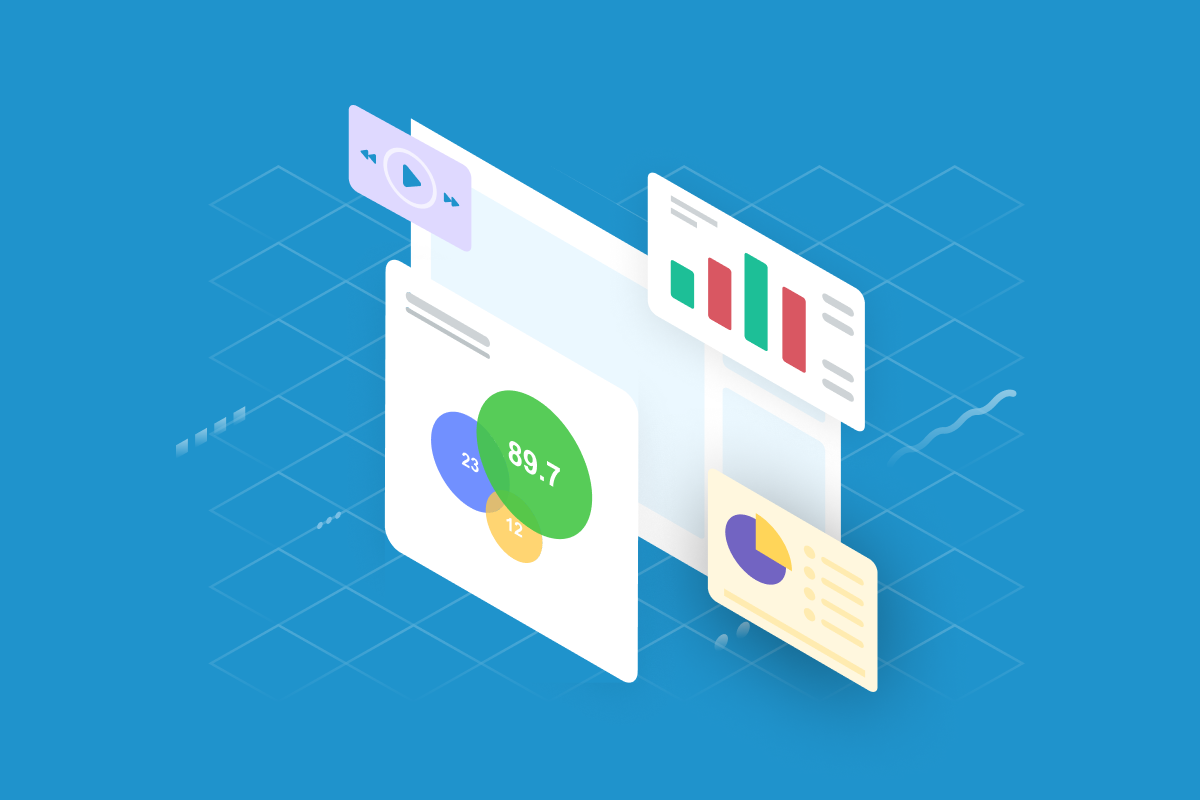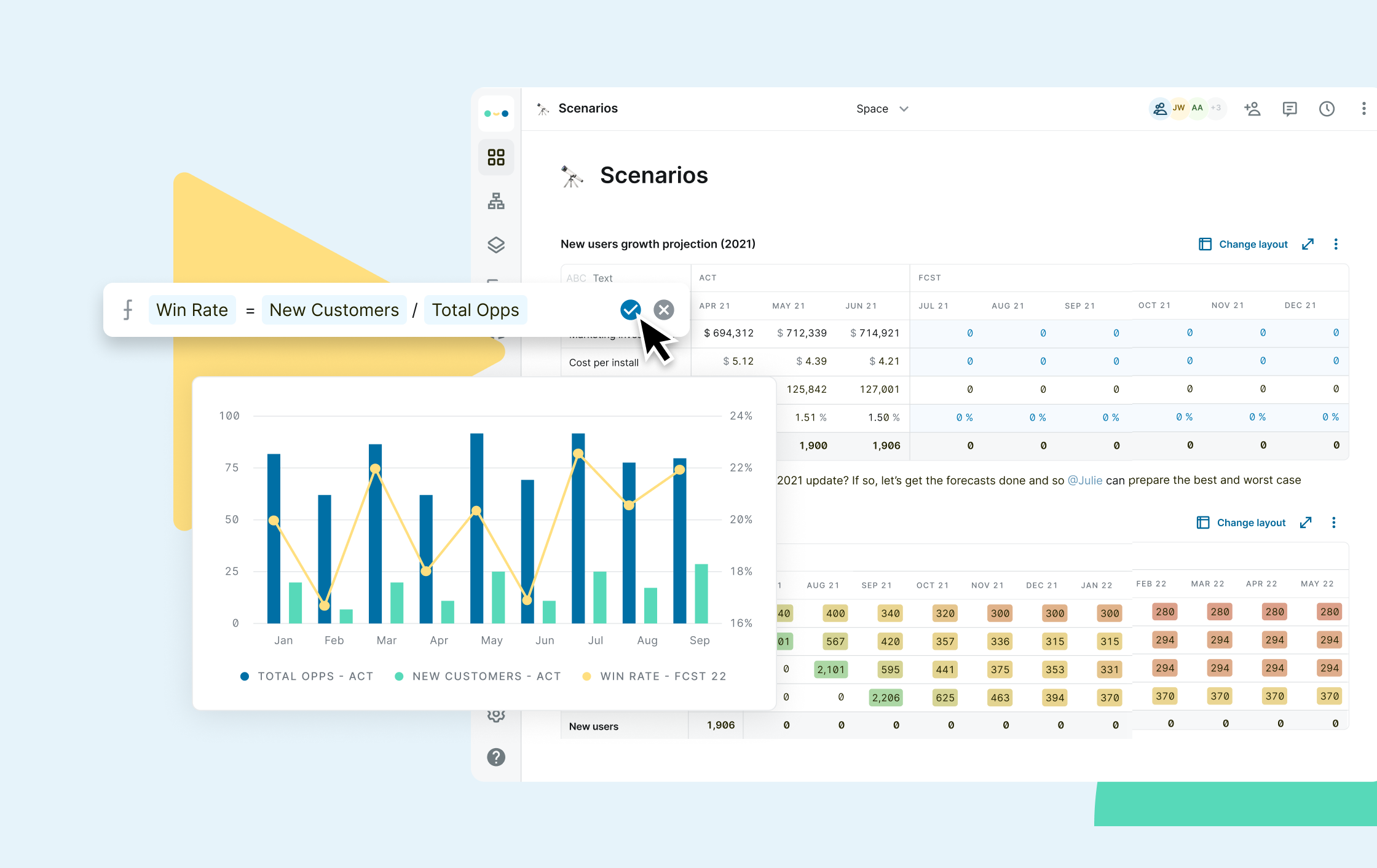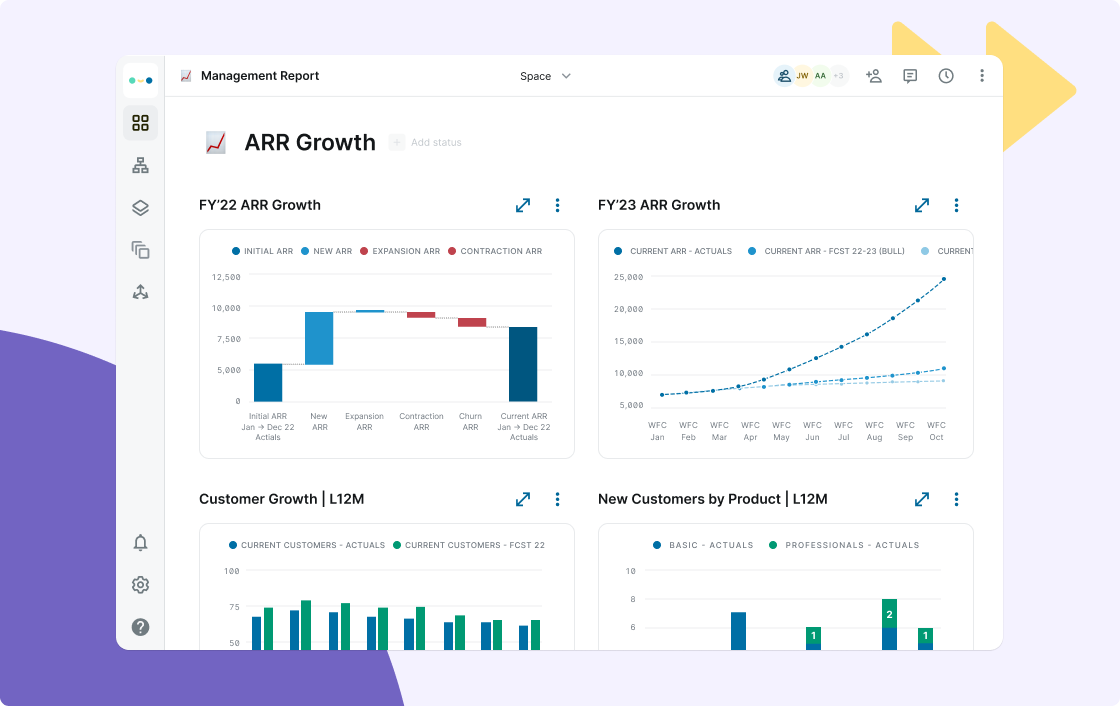
Headcount planning best practices: What to know in 2023
Learn more ->

, Chief of Staff, Abacum
11 min read · Published: August 10, 2023

🎯 Introduction
Scenario planning is a crucial tool that businesses can use to navigate uncertain and ever-changing environments. By exploring different future scenarios and their potential impacts, businesses can develop strategies that are robust and resilient.
Below we will delve into the basics of scenario planning, the steps involved in implementing it effectively, expert tips to enhance the process, and answer common questions regarding its role in finance.
So, let’s dive in and gain a deeper understanding of scenario planning and its significance in business strategy.
Scenario planning involves envisioning different possible futures and analyzing their implications for a business. It goes beyond traditional forecasting methods by considering a range of plausible outcomes rather than relying on a single prediction. This approach allows businesses to be better prepared for uncertainties and make informed decisions.
When engaging in scenario planning, businesses take into account various factors such as market trends, technological advancements, regulatory changes, and consumer behavior. By exploring different scenarios, businesses can anticipate potential challenges and opportunities, enabling them to develop strategies that are robust and adaptable.
Furthermore, scenario planning encourages a forward-thinking mindset within organizations. It prompts leaders and decision-makers to think beyond the immediate future and consider the long-term implications of their actions. This strategic perspective helps businesses navigate through complex and unpredictable environments, ensuring their resilience and sustainability.
There are several approaches to scenario planning, each with its own benefits and considerations. One common approach is the intuitive approach, where scenarios are developed based on expert judgment and subjective insights. This approach allows for flexibility and creativity, as it harnesses the knowledge and experience of individuals within the organization.
Another approach is the quantitative approach, where scenarios are created using mathematical models and statistical analysis. This method relies on data-driven insights and objective measurements to develop scenarios. It provides businesses with a more structured and systematic way of analyzing potential futures, enabling them to make informed decisions based on empirical evidence.
Lastly, the participatory approach involves engaging key stakeholders to collectively develop scenarios, promoting collaboration and diversity of perspectives. This approach recognizes the value of input from various stakeholders, including employees, customers, suppliers, and industry experts. By involving a wide range of perspectives, businesses can gain a more comprehensive understanding of potential scenarios and develop strategies that are inclusive and sustainable.
Regardless of the approach chosen, scenario planning requires careful consideration of uncertainties and assumptions. It involves identifying critical uncertainties, which are factors that have a significant impact on the future outcomes. By assessing the potential impact of these uncertainties, businesses can develop strategies that are robust and adaptable to different scenarios.
In today’s rapidly changing business landscape, scenario planning is more critical than ever. It allows businesses to identify potential threats and opportunities, assess the impact of various decisions, and adapt their strategies accordingly. By considering multiple scenarios, businesses can be proactive rather than reactive, enabling them to stay ahead of the curve and mitigate risks effectively.
Scenario planning also enhances strategic agility within organizations. It enables businesses to anticipate and respond to disruptive events or changes in the external environment. By developing strategies that are flexible and adaptable, businesses can navigate through uncertainties and capitalize on emerging opportunities.
Moreover, scenario planning fosters a culture of innovation and continuous learning. It encourages businesses to think creatively and explore alternative futures. Through scenario planning, organizations can challenge existing assumptions, test different strategies, and learn from their experiences. This iterative process of learning and adaptation strengthens the overall strategic capabilities of the business.
In conclusion, scenario planning is a valuable tool for businesses to navigate through uncertainties and make informed decisions. By exploring different scenarios, businesses can anticipate potential challenges, identify opportunities, and develop strategies that are robust and adaptable.
Implementing scenario planning can be a complex process, but breaking it down into five key steps can make it more manageable and effective.
Scenario planning is a strategic tool used by businesses to anticipate and prepare for future uncertainties. It involves creating multiple plausible scenarios and analyzing their potential impact on the organization.
By considering a range of possible futures, businesses can make more informed decisions and develop strategies that are robust and flexible.
Successful scenario planning requires the involvement of key stakeholders from different departments and levels of the organization. By engaging a diverse range of perspectives, businesses can develop more comprehensive scenarios and gain valuable insights into potential risks and opportunities.
Collaboration is essential to ensure that all relevant factors and perspectives are considered. By involving stakeholders from various areas of the business, including finance, operations, marketing, and human resources, businesses can gather a wealth of knowledge and expertise. This collaborative approach helps to identify blind spots and challenges assumptions, leading to more robust and realistic scenarios.
A robust financial model forms the foundation of strategic planning. By creating a baseline financial model that accurately reflects the current state of the business, including revenue, expenses, and key performance indicators, businesses can evaluate the financial impact of different scenarios more accurately.
The baseline financial model provides a starting point for scenario analysis. It allows businesses to understand their current financial position and performance, serving as a reference point for comparison with alternative scenarios. By capturing the key drivers of the business, such as sales growth, cost structure, and market dynamics, the financial model provides a solid basis for evaluating the potential outcomes of different scenarios.
Financial models need to be flexible and adaptable to accommodate changes in business needs. As new information becomes available or circumstances evolve, businesses should regularly review and update their financial models to ensure their accuracy and relevance.
Scenario planning is an iterative process that requires continuous refinement. Businesses should regularly assess the assumptions and inputs used in their financial models and adjust them as necessary. This flexibility allows businesses to incorporate new insights, market trends, and emerging risks into their scenarios, making them more realistic and actionable.
Once the scenarios are developed, it is essential to present them in a clear and concise manner. Visual aids such as charts and graphs can help stakeholders understand the implications of each scenario and make informed decisions based on the presented information.
Effective communication of scenarios is crucial for generating buy-in and facilitating decision-making. Businesses should use visual representations to illustrate the key drivers, assumptions, and potential outcomes of each scenario. This visual approach helps stakeholders grasp the complexity of the scenarios and facilitates meaningful discussions around the potential risks and opportunities associated with each one.
Scenario planning is not a one-time exercise. To derive long-term benefits, businesses should foster a culture of continuous collaboration and learning. By regularly reviewing and updating the scenarios based on new insights and feedback, businesses can refine their strategies and adapt to changing circumstances effectively.
Dynamic scenario planning involves an ongoing process of monitoring, evaluating, and adjusting scenarios in response to internal and external changes. By encouraging open dialogue and knowledge sharing, businesses can tap into the collective intelligence of their teams and stay ahead of emerging trends and challenges. This continuous collaboration ensures that scenarios remain relevant and actionable, enabling businesses to navigate uncertainties with agility and resilience.
While the 5 steps provide a solid framework for scenario planning, there are additional expert tips that can further enhance the process of strategic planning.
Scenario planning is a powerful tool that allows businesses to anticipate and prepare for future uncertainties. By exploring different possible scenarios, businesses can develop strategies that are adaptable and resilient.
However, to truly maximize the benefits of scenario planning, it is important to consider these three expert tips:
Instead of waiting for external events to dictate their strategies, businesses should proactively create and update scenarios regularly. By continuously monitoring the external environment, they can identify early warning signs and adjust their plans accordingly, increasing their resilience and agility.
A proactive approach involves staying informed about industry trends, technological advancements, and geopolitical developments. By understanding the potential impact of these factors on the business, organizations can anticipate and prepare for different scenarios. This approach requires a mindset of constant learning and adaptation, as well as a willingness to challenge existing assumptions and strategies.
For example, a technology company might proactively consider scenarios where new competitors enter the market or where there are significant shifts in consumer preferences. By exploring these possibilities in advance, the company can develop contingency plans and make strategic investments to stay ahead of the curve.
Collaboration and partnership are critical in scenario planning. It is essential to involve stakeholders from various departments and levels of the organization, including finance, operations, marketing, and human resources. The insights and knowledge from these diverse perspectives can lead to more robust scenarios and better decision-making.
When different stakeholders come together, they bring their unique expertise and experiences to the table. This diversity of perspectives can help identify blind spots and uncover potential risks and opportunities that might have been overlooked. By fostering a culture of collaboration and open communication, organizations can tap into the collective intelligence of their teams and make more informed decisions.
Furthermore, involving external partners, such as industry experts, consultants, or customers, can provide additional insights and fresh perspectives. These external perspectives can challenge assumptions and bring new ideas to the scenario planning process, enhancing its effectiveness.
With advances in technology, businesses can streamline and automate their scenario planning processes. Software tools and platforms can assist in data collection, analysis, and scenario modeling, saving time and improving accuracy. By leveraging automation tools, businesses can focus more on analyzing the results and deriving actionable insights.
Automation tools can help gather and analyze large volumes of data from various sources, such as market research reports, customer surveys, and financial data. These tools can also facilitate scenario modeling, allowing businesses to simulate different scenarios and assess their potential impact on key performance indicators.
By automating repetitive tasks, businesses can free up valuable time and resources, enabling their teams to focus on higher-value activities, such as interpreting the results, developing strategic recommendations, and implementing action plans. Additionally, automation can reduce the risk of human error, ensuring the accuracy and reliability of the scenario planning process.
However, it is important to note that while automation tools can enhance efficiency, they should not replace human judgment and critical thinking. The insights generated by these tools should be used as inputs for decision-making, rather than being blindly followed.
By embracing a proactive approach, prioritizing collaboration and business partnership, and leveraging automation tools, businesses can enhance their scenario planning process. These expert tips can help organizations navigate uncertainties and make informed strategic decisions, ultimately increasing their competitiveness and long-term success.
Scenario planning is a crucial aspect of strategic decision-making for businesses in today’s dynamic and uncertain environment. It allows organizations to anticipate and prepare for various potential future scenarios, enabling them to respond effectively and proactively to changes in the market, competition, and other external factors.
One such automation tool that businesses can utilize to enhance their scenario planning efforts is Abacum.
Abacum is a cutting-edge scenario planning software that provides a comprehensive and user-friendly solution for financial planning, projection, and forecasting. It offers advanced financial modeling capabilities, collaboration features, and real-time scenario analysis, empowering businesses to make informed and data-driven decisions.

With Abacum, businesses can streamline their scenario planning processes and optimize their strategic decision-making. The platform’s advanced financial modeling capabilities enable organizations to create detailed and accurate financial models that reflect various scenarios and potential outcomes. This allows decision-makers to assess the financial implications of different strategies and make well-informed choices.
Real-time scenario analysis is a key feature offered by Abacum. The platform allows businesses to simulate and analyze different scenarios in real-time, providing instant insights into the potential outcomes and implications. This enables decision-makers to quickly assess the impact of various strategies and make timely adjustments if needed.

In addition to its powerful features, Abacum also offers a user-friendly interface that makes scenario planning accessible to users with varying levels of technical expertise. The platform’s intuitive design to ensure that businesses can leverage its capabilities without the need for extensive training or specialized knowledge.
Overall, Abacum is a valuable tool for businesses looking to enhance their scenario planning efforts. By leveraging its advanced financial modeling capabilities, collaboration features, and real-time scenario analysis, organizations can streamline their decision-making processes, improve their strategic outcomes, and navigate the complexities of an ever-changing business landscape with confidence.
Scenario planning serves a pivotal role in finance by enabling businesses to assess the financial impact of potential scenarios. This helps them evaluate different strategies, identify risks and opportunities, and allocate resources effectively.
One of the significant benefits of scenario planning is its enhancement of financial forecasting. By considering multiple scenarios, finance teams create a range of possible outcomes and their associated probabilities. This enables businesses to develop more accurate financial forecasts and make well-informed decisions about resource allocation, budgeting, and investment strategies.
Scenario planning allows businesses to evaluate different strategic options and their potential impact on financial performance. Through the creation and analysis of various scenarios, finance teams can assess the feasibility and effectiveness of different strategies, aligning decisions with long-term goals and maximizing financial returns.
Effective resource allocation is essential for financial success. Scenario planning enables businesses to identify resource requirements for various scenarios and allocate resources accordingly. By understanding the financial implications of each scenario, finance teams optimize resource allocation, ensuring the highest returns.
Scenario planning equips businesses with tools to adapt to changing circumstances. By considering various scenarios, finance teams can develop contingency plans and strategies to navigate uncertain times. This flexibility and preparedness minimize financial risks and enable businesses to seize opportunities in dynamic environments.